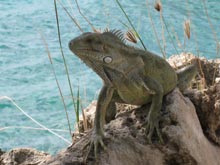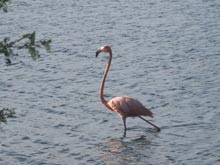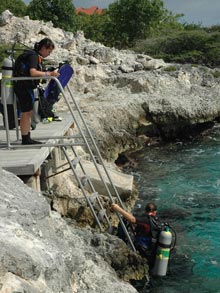A Different Kind of Mission
The animals encountered on the island of Bonaire are definitely different than those we would observe while at sea on a ship. Iguanas are seen all over the island. This particular iguana loved being photographed by the paparazzi. Click image for larger view and image credit.
Here's a another animal not commonly encountered by researchers on a ship. The pink flamingos are very common and inhabit saline ponds on the island of Bonaire. Click image for larger view and image credit.
January 23, 2008
Nicole Marie Brown Morris
Web Coordinator for Bonaire 2008
NOAA Office of Ocean Exploration and Research
Over the past year, I have had the opportunity to participate in a number of NOAA Office of Ocean Exploration and Research expeditions. After my time in Bonaire, I can tell this Bonaire 2008 mission is different by a number of factors. How is this mission different, you may ask?
The most obvious difference is this mission is shore-based. We are functioning from land. There is no large ship or vessel to operate from every day. Instead of conducting operations upon a large vessel, we launch the autonomous underwater vehicles (AUVs) and divers directly from shore or dive boats. This aspect of operation can be nice, because several different operations can happen at different locations on the island. For example, AUV operations can be conducted from one of the dive boats, while diver transects can be conducted at multiple dive sites along the island.
Since this mission is shore-based, the "home-base" for the science party is a villa, the Beachfront Hamlet. Most of the science party not only sleeps at the home base, but they also operate out of the Beachfront Hamlet. Daytime and late night science meetings and discussions occur in the house or on the back porch of the villa. This can be similar to the science party sleeping and conducting science from a large vessel, except not all members of the science party are located at the Beachfront Hamlet. Several members, including myself, are scattered at hotels along the leeward side of the island.
Communication and transportation is also different considering team members can be scattered throughout the island at any given time. Local cell phones and walkie-talkies are keeping everyone in contact, whether it is from hotel to Beachfront Hamlet or from kayak to shore. Rental cars and trucks and dive boats are used to transport the dive gear, people, and AUVs to various locations on and around Bonaire.
Noelle Relles and Hilary Stevens are entering the water from a nice platform at Oil Slick Leap dive site on Bonaire. They are preparing to conduct underwater video transects. Click image for larger view and image credit.
The scientific aspect of using three AUVs to collect data around Bonaire is another difference and the first time this has occurred. There are two Gavia AUVs: one can map the sea floor using multibeam bathymetry and side scan sonar and collect underwater video, and the other maps using side scan sonar and collects biological parameters, including water quality and video of the reef. The third AUV can map the sea floor (side scan sonar), collect water parameters (dissolved oxygen, temperature, salinity, pH), and color video of the sea floor.
So far, I have been very impressed by all the members of the science party and the science being conducted in Bonaire. I have really enjoyed learning about the different aspects of this mission and being able to participate in another science project. Ask me if I would come to Bonaire or participate in a shore-based expedition again, I would say “Yes” in a heartbeat!





























